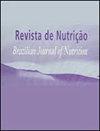Factors associated with non-frequent breakfast consumption in adolescents (EVA-JF Study)
IF 0.5
4区 医学
Q4 NUTRITION & DIETETICS
Revista De Nutricao-brazilian Journal of Nutrition
Pub Date : 2022-01-01
DOI:10.1590/1678-9865202235e210166
引用次数: 1
Abstract
ABSTRACT Objective To estimate the association of infrequent breakfast consumption with socioeconomic, behavioral, and individual factors in a sample of Brazilian adolescents from public schools. Methods Cross-sectional study with adolescents aged from 14 to 19 from public schools in Juiz de Fora, state of Minas Gerais. The frequency of consumption of breakfast, snacks, soft drinks, industrialized drinks, the usual food consumption, body mass index, body fat percentage, and waist circumference were evaluated. Other socioeconomic, behavioral, and individual data were obtained through questionnaires. Logistic regression analysis and hierarchical selection of variables were used to verify the associated factors. Results The sample consisted of 805 adolescents; 53.4% reported infrequent breakfast consumption. Through hierarchical logistic regression analysis, it was evidenced that the house occupancy status (OR: 0.618; 95%CI: 0.4410.865; p=0.005) was the distal factor associated with infrequent breakfast consumption; the intermediate factors were the consumption of industrialized beverages (OR: 0.658; 95%CI: 0.486-0.890; p=0.007) and percentage of energy from processed foods (OR: 0.935; 95%CI: 0.907-0.964; p<0.001); and the proximal factors were the male gender (OR: 0.696; 95%CI: 0.520-0.932; p=0.0015) and being nonwhite (OR: 1.529; 95%CI: 1.131-2.069; p=0.006). Conclusion Male adolescents who lived in owned houses, with occasional consumption of industrialized beverages and a higher percentage of energy derived from processed foods, had lower chances of infrequent breakfast consumption, while non-white adolescents had higher chances.青少年不经常吃早餐的相关因素(EVA-JF研究)
【摘要】目的评估巴西公立学校青少年不常吃早餐与社会经济、行为和个人因素之间的关系。方法对米纳斯吉拉斯州Juiz de Fora公立学校14 - 19岁青少年进行横断面研究。评估了早餐、零食、软饮料、工业饮料的消费频率、日常食物消费、体重指数、体脂率和腰围。其他社会经济、行为和个人数据通过问卷调查获得。采用Logistic回归分析和分层变量选择对相关因素进行验证。结果共805名青少年;53.4%的人表示不经常吃早餐。通过层次逻辑回归分析,证明房屋占用状况(OR: 0.618;95%置信区间:0.4410.865;P =0.005)是与不经常吃早餐相关的远端因素;中间因素为工业化饮料消费(OR: 0.658;95%置信区间:0.486—-0.890;p=0.007)和来自加工食品的能量百分比(OR: 0.935;95%置信区间:0.907—-0.964;p < 0.001);近端因素为男性(OR: 0.696;95%置信区间:0.520—-0.932;p=0.0015)和非白人(OR: 1.529;95%置信区间:1.131—-2.069;p = 0.006)。结论:住在自有住房的男性青少年偶尔饮用工业化饮料,从加工食品中获取能量的比例较高,不经常吃早餐的可能性较低,而非白人青少年的可能性较高。
本文章由计算机程序翻译,如有差异,请以英文原文为准。
求助全文
约1分钟内获得全文
求助全文
来源期刊
CiteScore
1.20
自引率
12.50%
发文量
24
审稿时长
6-12 weeks
期刊介绍:
Revista de Nutrição is former Revista de Nutrição da Puccamp, founded in 1988. It is a bimonthly publication every four months and it is of responsibility of the Centro de Ciências da Vida, da Pontifícia Universidade Católica de Campinas . It publishes articles that contribute to the study of Nutrition in its many sub-areas and interfaces; and is open to contributions of the national and international scientific communities.

 求助内容:
求助内容: 应助结果提醒方式:
应助结果提醒方式:


